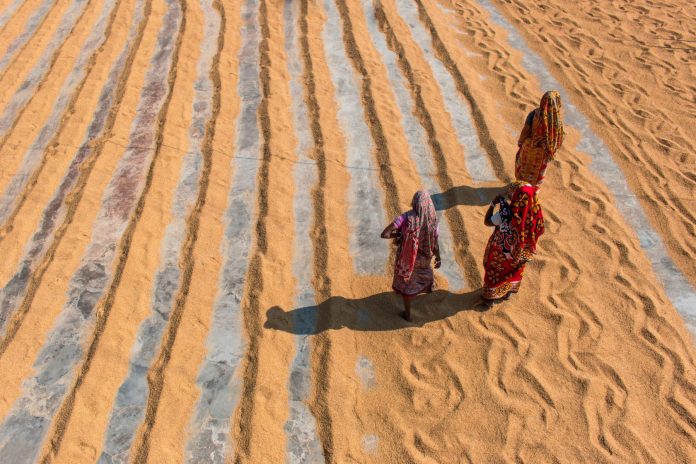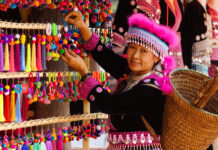
Climate change, food security and women farmers in Asia
Text Tamara Nair
Climate change will affect all of humanity: men and women, young and old, rich and poor. If there’s one thing that looks past race, religion, age and income status, it’s the effects of climate change. Of course, let’s not overlook the other living organisms – all flora and fauna. The impact of our changing planet will affect them, too.
But these effects will be felt quite differently by women – female food producers in particular. Due to traditional gender roles that enforce that women collect water, wood for fuel, and care for family members, women farmers have very little opportunity to learn new skills, access development opportunities, or even attend to their own health needs.

In the midst of the expected (and unexpected) changes in climate variability and its impacts on anthropogenic systems – such as our water supply and food production – it is heartening to note that the preamble of the Paris Agreement stresses the importance of helping developing nations reduce emissions and cope through adaptation, from the smallest to the largest changes. However, organisations such as Oxfam have come out to say that the agreement falls short in protecting rural women farmers.
Speaking at the Sustainable Business Forum in Singapore, Jeannette Gurung, Executive Director of Women Organising for Change in Agriculture and Natural Resource Management (WOCAN) said that the greatest challenge is the lack of recognition and value of women’s inputs to farming systems across Asia and the developing world. In light of this bias, which contributes to the persistent and dominant view of the farmer as male, and to gender-specific constraints, women farmers are normally seen as “farmers’ wives” rather than economic producers in their own right. Women are responsible for between 60 to 80 percent of agricultural production across Asia, and yet receive a fraction of the land, credit and inputs (such as improved seeds and fertilisers), agricultural training and information compared to men.
The question arises, then, what can be done to protect and aid female food producers in Asia in the face of an uncertain climate future? Small-scale farms produce around 80 percent of Southeast Asia’s food, and women account for 43 percent of the agricultural labour force. In some countries, such as Thailand, they account for the bulk of agricultural labour, performing almost 90 percent of the work carried out in rice fields. And yet, women farmers are not easily compensated in times of natural or financial crises with resource allocation in the forms of land and capital. They also tend to be excluded from rebuilding and rehabilitative strategies.

It would be incorrect to say that this exclusion of women has been deliberate, for cultural or other reasons, in agricultural development. As a matter of fact, research points to how Southeast Asia’s female food producers fare much better than their counterparts in other parts of Asia or Africa. There are varying degrees of empowerment across the region, with the Philippines and Thailand displaying greater levels of empowerment initiatives for female farmers.
In short, regional trends seem to run counter to narratives that paint female food producers as disempowered members of rural communities.
Despite these positive revelations, there are some troubling commonalities across the region. These include underestimating the nature of the work women do, and ignoring their limited access to research and development, such as new innovations in agriculture.
“Women’s work” remains underrated and not fully, if at all, accurately priced. In rural areas across the region, women are almost exclusively responsible for food and nutrition security for their families. A large proportion of work on farms is done by women; in addition, women are also involved in post-harvest activities such as storage, handling, stocking, processing and marketing.
Employment surveys often target the formal sector, which means that most of the data collected primarily reflect men’s experiences, as much of the agricultural work that women do may not be classified as “formal” sector labour, including the work they do as farm workers. This leaves a significant gap in knowledge, which makes for poor planning in management strategies. Such incomplete information becomes dangerous when planning for climate change mitigation and implementing adaptation efforts. Not only will such skewed data create unsustainable policies that undermine the economic security of half the population, it can also severely compromise the household food security of rural communities. Women spend a significant proportion of their income on food, in addition to what is cultivated by them for their families. A loss of their income could translate not only to reduced food, but also to reduced healthcare and education opportunities for their children.
Additionally, technology including climate-smart agricultural developments, is not often extended to female farmers, and it is mostly men who have the opportunity to attend workshops and training programmes. Often, the assumption is that the head of the household is male, and he is then automatically invited to participate. This idea is flawed, especially when we start to examine the rural-urban migration trends; men increasingly leave farms for cities in search of jobs, leaving women in the rural areas to tend to the land to produce food.

Unfortunately, agricultural research and development programmes that aim to address issues of climate change in food production do not often take into consideration the perceptions and concerns of both men and women. There is, however, some hope in the form of institutions, such as the International Rice Research Institute (IRRI). Increasingly, the IRRI has been looking at the gendered impact of agricultural technology (linked to producing climate-smart rice) on female and male farmers in the region. This is a positive sign that leaves much hope for women farmers to increase their knowledge on rice production in light of climate change’s impact on food security.
According to the United Nations Food and Agriculture Organization (FAO), we need to increase our food production by around 60 percent from recorded 2007 levels if we are to feed the 9 billion people estimated to inhabit the planet by 2050. And, as Gurung explains with optimism, “giving women the same access as men to agricultural resources could increase production on farms in developing countries by 20 to 30 percent.”
In Southeast Asia, although there has been development in rural areas, much remains to be done, especially in terms of setting up sustainable climate-smart agricultural policies involving both men and women. Whichever measures are taken, they will not only have to positively impact female food producers and the region’s food security, but they will also have to have significant global implications in terms of confronting and working to counteract climate change. Such an approach would be the most cost-effective and “green” way to help women, and help the planet.
Ideas continue to be raised and discussed, but they require the necessary political will and financial backing. One such idea is to use a form of biomimicry to prevent food insecurity, empower women and protect the planet simultaneously. Studies of how the human body reacts in hot environments might provide some insights into creative designs that could do this. One such technology is called the Evaptainer, a device that uses evaporative cooling to keep food from rotting, without the use of electricity, working in the same way that the human body cools itself through perspiration.
My colleague, Christopher Lim, and I have proposed that a similar mechanism be introduced in rural Southeast Asia through the development of cottage industries to mass-produce these low-cost containers, creating jobs to supplement agricultural work. This could help empower women farmers by offering them much-needed income as a means of establishing better economic security. The benefit of these measures could allow us to secure a sustainable source of green energy, focusing on rural development and capacity building, and effectively narrowing the gender gap in sustainable climate-smart agriculture.
To this end, any worthwhile attempt at strengthening the resilience of communities in the face of climate change and food security needs to reach out to women. In this regard, the Association of Southeast Asian Nations (ASEAN) has established a regional commission to protect women’s interests. The ASEAN Commission on the Rights of Women and Children (ACWC), established in 2010, implemented a four-year work plan, which concluded in 2016, studying the social impacts of climate change on women and children, among other areas. These types of platforms are working tirelessly to bring the issue to light, and implement programmes of change. The work plan for 2016-2020 is currently in progress.
Beyond being mothers, wives, daughters and sisters, women have a significant role in feeding the world’s projected nine billion by 2050. A better understanding of the role of women in food production is desperately needed. The women of Asia have time and again revealed their resilience, especially in times of crisis. It is time to harness that strength.
For more stories and photographs from the issue, see Asian Geographic Issue 123, 2017










